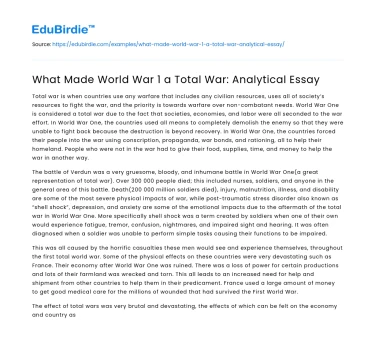Introduction
World War I, often referred to as the Great War, marked a significant turning point in modern history, not solely due to the magnitude of the conflict but also because of the concept of "total war" it introduced. Total war, a term denoting a war in which nations mobilize all available resources and target both military and civilian infrastructure, was vividly manifested during World War I. This essay delves into the key elements that rendered World War I a total war, examining the expansive mobilization of national resources, the extensive impact on civilian life, and the global scale of the conflict. By analyzing these facets, we can better understand how World War I transformed the nature of warfare and laid the groundwork for future global conflicts. The unprecedented scope and intensity of this war have left an enduring legacy, influencing political, social, and economic structures worldwide.
Comprehensive Mobilization of National Resources
One of the primary characteristics that distinguished World War I as a total war was the comprehensive mobilization of national resources. Unlike previous conflicts, World War I necessitated the full engagement of a nation's industrial, human, and economic capacities. The belligerent countries harnessed their industrial sectors not only to produce arms and ammunition but also to innovate in warfare technology, leading to the development of tanks, airplanes, and chemical weapons. As historian Hew Strachan posits, "The war was won by the side that managed to sustain its industrial base and out-produce the other in terms of war materials" (Strachan, 2001).
Save your time!
We can take care of your essay
- Proper editing and formatting
- Free revision, title page, and bibliography
- Flexible prices and money-back guarantee
Moreover, human resources were mobilized on an unprecedented scale, with millions of men conscripted into the armed forces. This mass conscription was mirrored by a corresponding mobilization on the home front, where women and non-combatants were drafted into war-related industries, effectively blurring the lines between civilian and military roles. The economic structures of nations were also redirected towards the war effort, with governments imposing rationing, controlling prices, and diverting resources to support military needs. This all-encompassing mobilization ensured that the war permeated every aspect of life, making it a truly total war.
The transition from peacetime economies to wartime economies was not without its challenges. Critics argue that such extensive mobilization led to significant economic disruption and hardship, with inflation and shortages affecting civilian populations. However, proponents of the total war strategy contend that this approach was essential for achieving military objectives and ultimately securing victory. The debate highlights the complex interplay between military necessity and civilian welfare during times of total war.
Impact on Civilian Life and Global Scale
The impact of World War I extended far beyond the battlefield, affecting civilians on a scale never before seen. The war brought about not only direct military engagement but also significant civilian casualties due to blockades, air raids, and the disruption of daily life. The use of blockades, such as the British naval blockade of Germany, aimed to cut off essential supplies and weaken the enemy's resolve, but it also resulted in severe shortages and suffering for civilian populations. As the war progressed, the distinction between combatants and non-combatants became increasingly blurred, with civilian areas frequently targeted to undermine morale and cripple the enemy's capacity to wage war.
Furthermore, World War I's global scale amplified its impact on civilian life. The war drew in nations from every continent, making it a truly global conflict. Colonies and territories from Africa, Asia, and the Americas were not only involved in providing troops and resources but also became arenas of warfare themselves. This global dimension meant that the war's repercussions were felt worldwide, altering international relations and colonial dynamics. The Treaty of Versailles, which concluded the war, reshaped national boundaries and sowed the seeds for future conflicts, illustrating the far-reaching consequences of World War I as a global total war.
While some argue that the war's global reach exacerbated existing tensions and inequalities, others maintain that it was a necessary step in the evolution of modern warfare. The debate underscores the dual nature of total war: while it can lead to widespread destruction and hardship, it also fosters technological and strategic advancements that redefine military capabilities. This paradox reflects the complex legacy of World War I as a total war.
Conclusion
In conclusion, World War I epitomized the concept of total war through its comprehensive mobilization of national resources, profound impact on civilian life, and global scale. The extensive use of industrial, human, and economic resources underscored the war's reach, while the blurred lines between civilian and military spheres highlighted the all-encompassing nature of the conflict. Despite the devastating consequences and ethical dilemmas associated with total war, World War I set a precedent for future conflicts, shaping contemporary understandings of warfare and international relations. The war's legacy continues to influence how nations perceive and engage in conflict, reminding us of the profound and lasting effects of total war on societies worldwide.
Ultimately, World War I's classification as a total war underscores the transformative impact of the conflict, both in terms of its immediate outcomes and its enduring influence on global history. As we reflect on this pivotal period, we are reminded of the complexities and challenges inherent in total war, as well as the necessity of learning from the past to navigate future conflicts more effectively. Through this lens, the Great War serves as both a cautionary tale and a catalyst for change, highlighting the intricate interplay between military strategy, civilian life, and global dynamics.






 Stuck on your essay?
Stuck on your essay?

